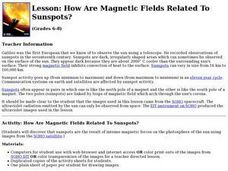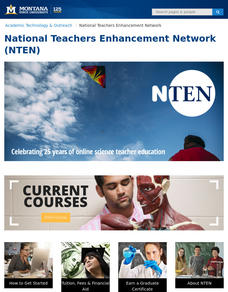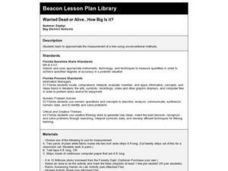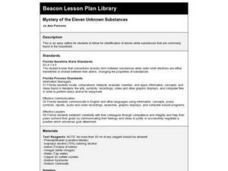Curated OER
At Home on the Prairie
Learners discover the importance of the bison within the prairie ecosystem and Native American culture, and explain the importance of habitat and place to living organisms.
Curated OER
Maintaining Body Heat
Students observe and compare heat loss in different objects with surface-to-volume ratios. They transfer this comparison to the physical characteristics of animals in their environment. They focus on how whales maintain their body heat.
Curated OER
How Are Magnetic Fields Related To Sunspots?
Students discover that sunspots are the result of intense magnetic forces on the photosphere of the sun by observing images from the SOHO satellite.
Curated OER
Through A Pinhole
Students construct a pinhole camera using their knowledge of the physics of light. This interdisciplinary activity give students hands-on experience in understanding the production and processing of photographic images.
Curated OER
Adaptation Scavenger Hunt
Fourth graders recognize the specific adaptations of living things and relate them to survival within the animals environment. They study common plants and animals found in Utah environments and how they have adapted to the environment...
Curated OER
Environmental Differences
Students observe and conduct an experiment to see whether differences in salinity (the environment) have an affect on the hatching rate and survival of brine shrimp.
Curated OER
Red River of the North Flooding 1997
Students describe factors that affect the flow of rivers and explain their relationships. They research the factors involved in flooding events. describe the effects of present and future practices in land use, and river control methods.
Curated OER
Surface Meteorological Observation System (SMOS)
Students monitor local surface weather conditions for at least 30 days. They interpret the data by graphing it and detemining percentages.
Curated OER
Hail Stone Impact
Sixth graders study the formation of convective storms and test mock hailstones. they graph and analyze collected data.
Curated OER
The Atrazine Dilemma
Students understand how farming practices and the topography of a region can effect the health and safety of all living things. Students play a game which helps them understand how the chemical Azatrine has spread in the watershed.
Curated OER
Wanted Dead or Alive...How Big Is it?
Fourth graders estimate the measurements of trees using unconventional techniques.
Curated OER
Mystery of the Eleven Unknown Substances
Fourth graders identify eleven white substances that are commonly found in the household. They, in pairs, perform experiments on a variety of substances, and must identify them based on the reactions they observe.
Curated OER
Raquel's Radishes
Sixth graders develop a reasonable hypothesis for a fictional science fair investigation. 'Raquel' is going to grow radishes and test for the best way to nourish them. They create a bar graph and write conclusions.
Curated OER
Dino Detectives
As students examine maps of Utah, 4th graders search for clues about what prehistoric life was like in Utah.
Curated OER
Trees!
Young scholars are introduced to the parts of trees through discussion and participation in learning centers with hands on activities that focus on each part.
Curated OER
Arkansas and Louisiana Purchase Wetlands
Students experiment to determine the value and importance of wetlands in Arkansas. They develop an environmental appreciation for wetlands.
Curated OER
Take a Closer Look
Students examine how to determine the species of a tree through the examination of the bark and leaves. They create tree rubbings, match bark samples with trees on a nature walk, match leaves using a tree identification guide, and...
Curated OER
Take a Dip: Sticky Water
Students complete lab activities to investigate the "sticky" properties of water, such as surface tension and capillary action, due to the polarity of the molecules.
Curated OER
Mud in the Water
Learners build a soil erosion model to study the importance of soil conservation. They investigate how land forms from both constructive and destructive forces.
Curated OER
Sink or Float Experiment
Students participate in an experiment to determine which objects float or sink. They use different amounts of salt for the objects and discover as the salt content increases, objects will float. They record their predictions and what...
Curated OER
Observing and Experimenting with Life Cycles: Mealworm Project
Young scholars participate in a hands-on experiment to observe mealworms going through a life cycle. Students conduct the experiments at home on their own and record their predictions and observations on student worksheets
Curated OER
A Journey of Discovery with RXTE
Students complete different missions to examine the topic of x-ray sources. They use satellite images and websites to gather the information they need to complete the lesson. They complete a worksheet to end the lesson.
Curated OER
Soil Permeability & Texture
Students investigate types of soil to test their water permeability. They collect soil samples, make predictions, conduct the experiment, and answer conclusion questions.
Curated OER
Wetlands/Watershed Model
Pupils work together to create a watershed model. They discover the flow of surface water on different topography. They examine how materials originate from miles away and end up in a different wetland.
Other popular searches
- Plains Indians
- Great Plains
- Buffalo Plains Indians
- Boss of the Plains
- Plains Indian War
- American Great Plains
- Flood Plains
- Great Plains Buffalo
- Planet Earth Great Plains
- Great Plains Indians
- Settling the Great Plains
- Coastal Plains

























